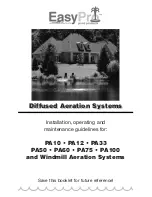
3. Block off suction as close to pump as possible and determine if pump will develop a vacuum.
a) If pump does not develop vacuum, and pump has sufficient
“
priming water
”
:
1. Tighten all bolts and fittings on suction side.
2. Check voltage to make sure pump is up to speed.
3. Open pump and check for clogging or obstruction.
4. Remove and replace shaft seal.
b) If pump develops a vacuum, check for blocked suction line or strainer, or air leak in suction piping.
E) Low flow - Generally, Check for:
1. Clogged or restricted strainer or suction line; undersized pool piping.
2. Plugged or restricted discharge line of filter (high discharge gauge reading).
3. Air leak in suction (bubbles issuing from return fittings).
4. Pump operating under speed (low voltage).
5. Plugged or restricted impeller.
F) Noisy pump - Check for
1. Air leak in suction causing rumbling in pump.
2. Cavitation due to restricted or undersized suction line and unrestricted discharge lines.
Correct suction condition or throttle discharge lines, if practical.
3. Vibration due to improper mounting, etc.
4. Foreign matter in pump housing.
5. Motor bearings made unserviceable by wear, rust, or continual overheating.
Specification Table
Pump
Reference motor
Nominal power
Voltage
Frequency
Phase
Amperage
Capacitor
Maximum Total
Head
SWP120551
SWP120551
610 W
230 V
50 Hz
1 Phase
2,6 A
18 µF, 450 V
14,1 M
SWP120751
SWP120751
790 W
230 V
50 Hz
1 Phase
3,4 A
18 µF, 450 V
14,6 M
SWP121051
SWP121051
920 W
230 V
50 Hz
1 Phase
4,0 A
18 µF, 450 V
15,7 M
SWP121551
SWP121551
1110 W
230 V
50 Hz
1 Phase
4,8 A
30 µF, 450 V
16,8 M


























